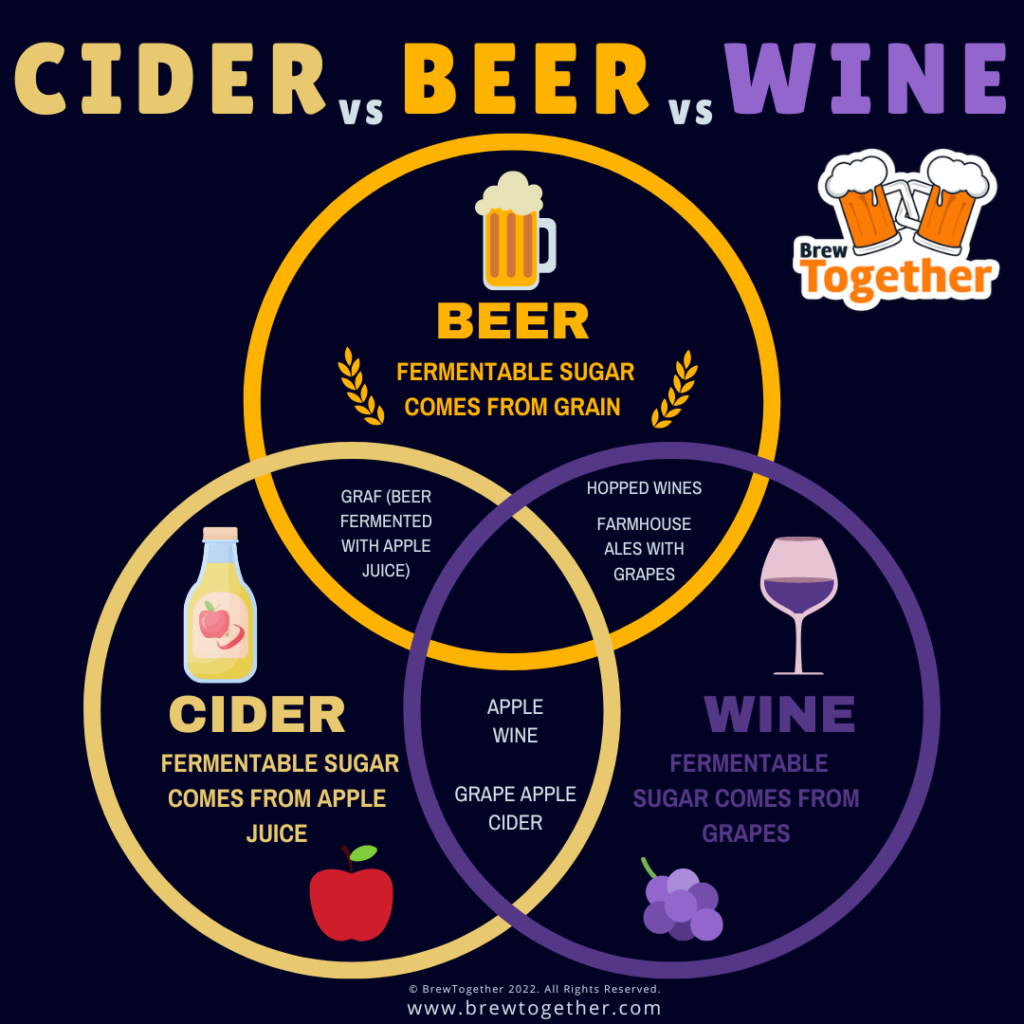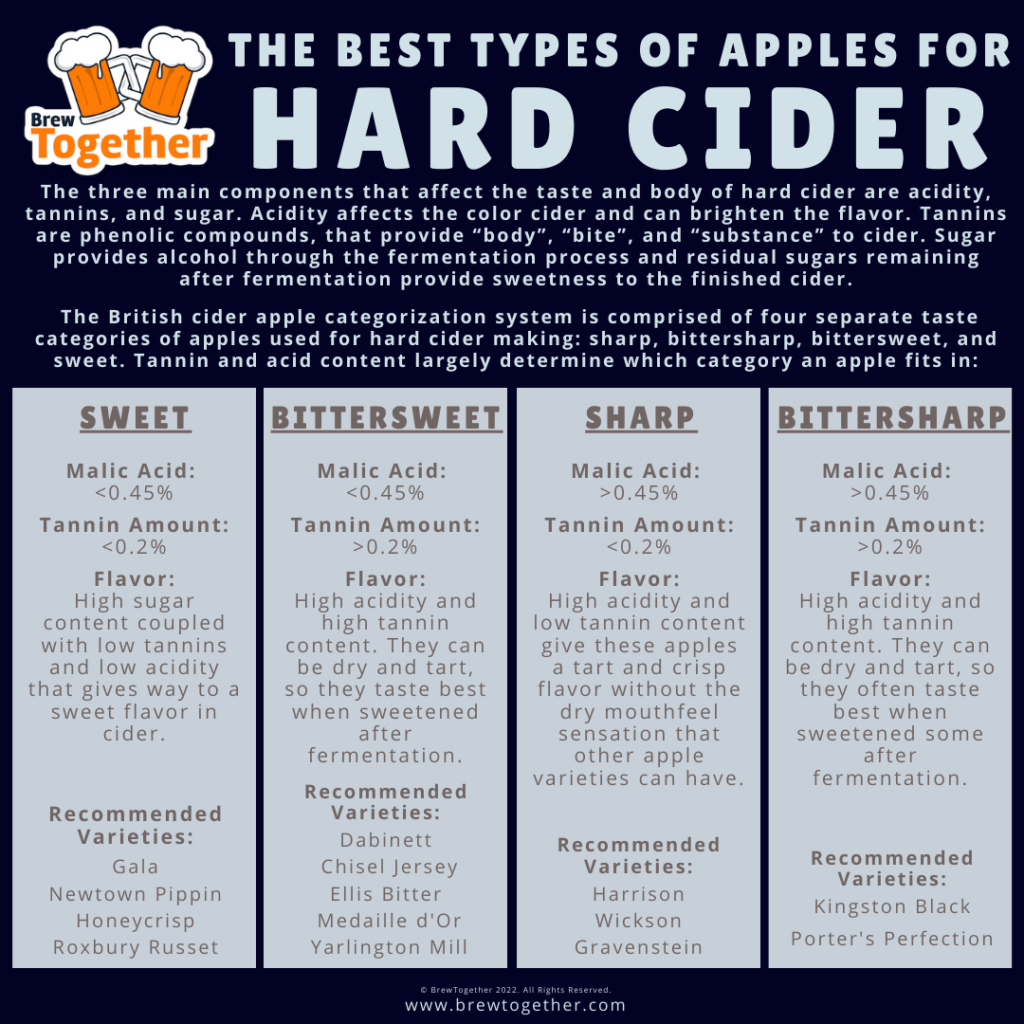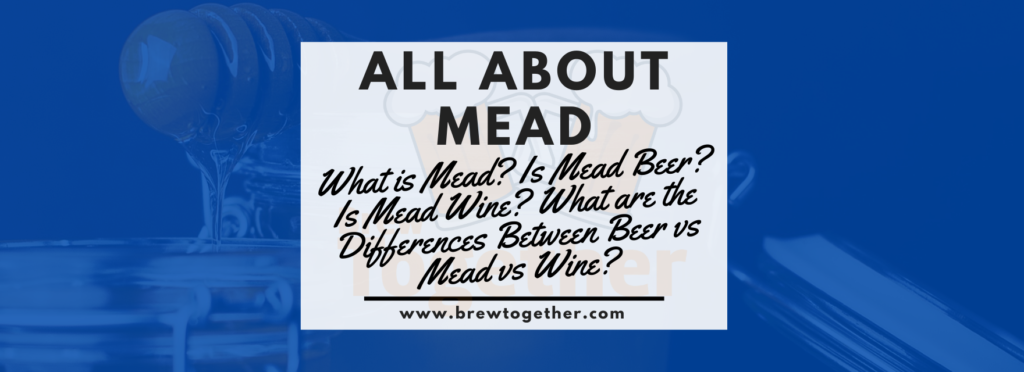The Ultimate Guide to Hard Apple Cider: What Is Cider, How To Make Hard Cider, and Easy Homebrew Cider Recipes


I’m going to admit something that may surprise you: I’m not ALWAYS in the mood for a beer. As I have mentioned before, I’m a big believer in keeping a non-beer option on tap so that non-beer drinkers can be included in enjoying your delicious homebrew.
There are many non-beer options available for homebrewing (try this hard lemonade recipe or even this hard seltzer recipe!), but for non-beer homebrew recipes, you can’t do much better than a good homebrewed hard cider. Hard cider is delicious and easy to make at home with the equipment you already have for brewing beer, and even beer lovers can appreciate a good cider!
Hard cider is especially great during the fall months in the United States, when the apples can be freshly picked. A nice hard cider provides a great alternative to other fall beverages, like dark beer and spirits. If you’re not familiar with hard cider and want to try some before brewing your own, there are several brands of this popular alcoholic beverage that can be purchased from an average grocery store. Look for brands like Angry Orchard and Redd’s Apple Ale to find the cider section near the craft beer.
What is Hard Cider?
Hard cider is an alcoholic drink made from fermented apple juice. While other ingredients like honey, brown sugar, or fruit can be added to change the flavor or increase the alcohol, the main source of alcohol in cider must come from the natural sugars from pressed apples.
Cider vs Beer vs Wine
One of the first questions people tend to ask is “is cider beer?” or “what is cider beer?”. Cider is not beer, and cider is not wine (and before you ask, no, cider is not mead!). While these popular beverages have several similarities, they also have many significant differences.


Differences in Ingredients
The major difference between cider, beer, and wine is the basic ingredients used to make each, especially the source of the sugar that is fermented to create alcohol. Beer is made by fermenting sugars drawn from grains. Grape wine is made from fermenting grape juice, although fruit wine is made with other fruit juice. Cider is made from fermenting apple juice. While the key difference in these beverages is the source of fermentable sugar, producing each requires different processes as well.
Differences in Process
In addition to the different sources of fermentable sugar, the process for making beer and cider is also quite different. Beer is brewed from sugars extracted from barley, as well as other cereal grains like rye and wheat.
At a high level, the beer brewing process involves:
- Malting grain, which is a process in which the grain is steeped in water, allowed to germinate, and then dried.
- Mashing the grain, which is a process in which the grain is milled to remove the outer layer and crack the grain, then put in hot water at specific temperatures to activate enzymes in the grain that extract the sugars into the water, which is now known as wort.
- The wort is then boiled, with hops added during specific parts of the boil to impart bitterness, aroma, and flavor.
- After the boil, the wort is cooled, transferred to a fermenter, and the yeast is added. The wort then ferments, which is the process by which the yeast consumes the sugar and produces alcohol. This process turns the wort into beer.
Unlike beer, cider is produced by fermenting sugar from apple juice. While small amounts of grain may be added to some types of cider for flavor or body, the primary fermentable sugar must come from apples for the beverage to be considered cider.
Because cider is made from fermenting apple juice, the process to produce it is a bit different than the process for producing beer from grains. At a high level, the cider brewing process involves:
- Pressing apples to gather apple juice
- Pasteurizing the apple juice to remove wild yeast and bacteria (optional)
- Mixing apple juice and any desired flavoring ingredients and in a fermentation vessel.
- Adding cider yeast to the juice
- Sealing the fermenter with an airlock and allowing fermentation to complete, which usually takes at least two weeks to a month.
- After fermentation has completed, the cider may be transferred to a secondary fermentation vessel, where it may be stored for a few months of conditioning (optional).
- Finally, the cider is kegged or bottled and is then ready for consumption.
As you can see, the cider making process is a bit simpler than the beer brewing process, because it does not require malting, mashing, or sometimes even boiling. Based on the differences in production and the differences in the source of primary fermentable sugar, cider is not beer, nor is it technically wine. Cider is a bit more similar to wine, and apple wine does exist. The primary difference between wine and cider is how it is made. Apple wine is often fermented and aged the same way wine is, including aging in oak barrels. Apple wine is similar to white wine made from grapes, and can sometimes have a flavor similar to chardonnay. Cider is more like beer in terms of its fermentation/aging process, alcohol content, and consumption.
Sweet Cider vs Dry Cider
These terms can be a bit confusing because some terms that cider makers use can refer to a couple of different things. Sweet cider can refer to unfermented (nonalcoholic) apple cider, which is just the juice of pressed apples. Sweet cider can also sometimes refer to sweet hard cider, which is fermented, alcoholic apple cider that has been sweetened for consumption.
Dry cider, on the other hand, refers to fermented, alcoholic apple cider, usually one that has not been sweetened for consumption. This means that all of the sugar in the cider has been converted to alcohol, leaving a “dry” sensation when consumed, similar to the sensation of red wine.
Dry ciders have less sugar than sweeter ciders, but sweet ciders often have a lower alcohol content than dry ciders, though this is not always the case. The amount of sugar present in the juice before fermentation and the alcohol tolerance of the yeast used is responsible for whether the finished cider has a lower or higher alcohol content.
How is Hard Cider Made?
Hard cider is made by fermenting the juice of apples, though different ingredients and spices may be added to enhance flavors. At a high level, the cider making process involves:
- Pressing apples to gather apple juice
- Pasteurizing the apple juice to remove wild yeast and bacteria (optional)
- Mixing apple juice and any desired flavoring ingredients and in a fermentation vessel.
- Adding cider yeast to the juice
- Sealing the fermenter with an airlock and allowing fermentation to complete, which usually takes at least two weeks to a month.
- Make sure you keep the fermenting cider out of direct sunlight.
- You can let cider ferment through primary fermentation in a single primary fermentater at room temperature. Like beer, the temperature that cider is fermented at affects the flavor. Check out our Guide to the Best Yeast for Cider to see recommended cider yeasts and their ideal fermentation temperature ranges.
- After fermentation has completed, the cider may be transferred to a secondary fermenter, where it may be stored for a few months of secondary fermentation /conditioning. This step is optional.
- Finally, the cider is kegged or bottled and is then ready for consumption.
Basic Methods for Making Hard Cider at Home
There are three basic methods that homebrewers use to make hard cider at home.
The first way, which is how most people get started, is to purchase unfermented sweet cider from a farm or store and ferment it at home using brewer’s yeast. Even some store bought apple juice can be used to make hard cider. Just make sure that it doesn’t contain any preservatives that will inhibit the yeast’s ability to ferment the sugar.
The second way to make cider at home involves growing or purchasing apples and pressing the juice out of them to make the cider.
The third way to make cider, which is especially good for beginners, is to purchase a homebrew cider kit, which can be purchased from a homebrewing or home winemaking supply store. These kits take a lot of the guesswork out of how to make cider, which helps new cidermakers make an excellent cider on their first try.
Equipment Needed for Making Hard Cider
Cider making, like homebrewing in general, can be as simple or as complex as you want it to be. The simplest way to make cider is from purchased apple juice or unfermented cider, which requires very little equipment. You can make a gallon of cider as simply as allowing a gallon of unpasteurized sweet apple cider ferment naturally from wild yeast already present in the beverage.
As you begin to invest more into the homebrewing hobby and start adding new equipment (here’s a few things we recommend), you’ll find that you may want to experiment with more advanced equipment, like an apple press or kegging equipment.
Equipment for Making Cider from Pasteurized Juice
For making a five-gallon batch of cider, you will need about 5.5 gallons of apple juice or unfermented apple cider. You will also need the following equipment:
- A primary fermenter
- Any fermenter works fine for cider. You can use something as simple as a food-grade 5-gallon bucket, a glass carboy, a glass jug, or even something as fancy as a stainless steel conical fermenter.
- Click here to see a comparison of the prices and features of our favorite conical fermenters to help you compare your options.
- Click here to see a comprehensive comparison of the pros and cons of plastic vs. glass vs. stainless steel fermenters to help you choose which type of fermenter you want to use for your cider.
- An air lock
- Sanitizer
- We recommend Five Star Chemicals Star San. It’s an inexpensive and easy to use no-rinse sanitizer, and we use it for all of our homebrews.
- Food grade plastic tubing for transferring your juice into the fermenter and from the fermenter to bottles or kegs.
- If your fermenter doesn’t have a valve on the bottom, we’d recommend adding either an autosiphon or a bottling bucket to your equipment list to make transferring, bottling, and kegging easier.
- Empty beer bottles or a keg
- If you’re using bottles, we recommend using a bottle filler to make things easier.
- While you can buy new empty bottles for homebrewing, it’s pretty easy to reuse bottles from commercial beer or cider. Click here to check out our guide to remove bottle labels so that you can use them for homebrewed cider.
Equipment for Making Cider from Unpasteurized Juice
If you’re going to boil unpasteurized juice, you’ll need everything above, but you’ll also need:
- A brew kettle large enough to boil 5 gallons of juice. At a minimum, we’d recommend a 7-gallon brew kettle to avoid messy boil-overs.
- A large stainless steel spoon to stir.
- Additives to kill unwanted yeast and support the health of wanted yeast, including:
- Campden Tablets (which can be sodium metabisulfite or potassium metabisulfite depending on the brand)
- Potassium sorbate
- Yeast nutrient
- Pectic enzyme if you’d like to remove as much haze as possible from the cider.
- A wort chiller is not 100% necessary, but it will greatly reduce the amount of time it takes to cool the juice after boiling, which will make life easier and also reduces the risk of wild yeast or bacteria in the air infecting your sanitized juice.
Homebrewing Hard Cider from Juice
When making cider from juice, you have two main options: unfermented apple cider or apple juice. While both can make great hard cider, the two have some differences.
Unfermented Cider From Orchards
Unfermented fresh cider can be purchased from grocery stores or local orchards. When purchasing unfermented cider as fresh juice from an orchard, check to see if it has been pasteurized. If it has been pasteurized, you can usually skip boiling it and put it right into a sanitized fermenter with your yeast. If it has not been pasteurized, it likely contains some wild yeast and bacteria. While wild yeast can produce complex, delicious cider, it can also easily produce a far less appetizing final product. Because wild yeast is inconsistent, for beginners we recommend pasteurizing your apple cider before fermenting it with your selected cider yeast.
Store Bought Apple Juice
For beginners, store bought apple juice or even apple juice concentrate is likely the best way to get started with making hard cider because it is cheap and easy to use. One of the most important things to note when making a simple, cheap cider from store-bought apple juice is whether there are preservatives in the juice
The juice you buy must be 100% preservative free apple juice. Any preservatives added to the juice will kill the yeast and prevent fermentation. Check the ingredients label for any preservatives, especially potassium sulfate or or sodium benzoate, which are often added as stabilizers. Generally, any juice marked as pasteurized is safe, and juice with vitamin C or ascorbic acid listed in the ingredients is fine as well.
If you’re ready to get started homebrewing hard cider from juice, check out our guide to homebrewing hard cider from juice for beginners! You can also check out our library of hard cider recipes. In each recipe, we provide an option for brewing it from apples or from store-bought apple juice.
Homebrewing Hard Cider from Apples
If you want to jump right into making cider right from whole apples, you’ll also need either a high-volume juicer, fruit crusher, or cider press. Apples can usually be purchased fresh from a local orchard in the fall months in the United States. Once you have extracted the juice from the apples and gathered your unfermented sweet cider, the process for brewing hard cider from apples is exactly the same as making it from apple juice. Just make sure you consider whether you want to kill off the wild yeast and bacteria that was present on the apples. You can do this by crushing up a campden tablet in the juice want waiting 24 hour before pitching your yeast.
Ready to get started with homebrewing hard cider from apples? Check out our step-by-step guide to homebrewing hard cider from apples! If you’re in the market for equipment, make sure to review our guide to the best cider presses available on the market now! You can also check out our library of hard cider recipes. In each recipe, we provide an option for brewing it from apples or from store-bought apple juice.
Best Apples for Making Hard Cider
In this section, we will provide a brief overview of how to choose an apple variety for cider as well as some recommended types of apples. If you’d like to learn more, we recommend reading our Guide to the Best Apples for Making Hard Cider, which reviews each style in detail and provides information about how it impacts fermented hard cider.
Many different apple varieties exist today, and some are better than others for brewing hard cider. Just because an apple tastes great fresh or in a pie does not necessarily mean it makes great cider.


Considerations for Choosing an Apple Variety
There are three main components that are important to take into account when brewing a cider, as they can largely affect the taste of the hard cider you brew: acidity, tannins, and sugar.
Acidity has the ability to affect the color of your hard cider, as a high acid content prevents oxidation from occurring too quickly, thereby slowing the process of your apples browning. With this in mind, a higher acidity content in your apples should produce a lighter color for your hard cider. Acidity can also brighten the flavor of your cider.
Tannins are chemical substances, specifically phenolic compounds, that provide “body”, “bite”, and “substance” to the flavor of your hard cider. Both acidity and tannins play an important role in hard cider brewing, with the ability to curb the growth of bad bacteria that could cause your entire batch of hard cider to spoil.
Finally, sugar, of course, is very important to the process of hard cider brewing, not only because it is crucial to the fermentation process (yeast gets hungry, of course!), but also because residual sugars can impact the flavor of your homemade cider.
Recommended Apple Varieties for Cider Making
All three of the components described above (acidity, tannins, and sugar content – referred to as brix) come together in various quantities to provide for the British cider apple categorization system. This categorization system is comprised of four separate taste categories of apples used for hard cider making — sharp, bittersharp, bittersweet, and sweet. Tannin and acid content largely affect the placement of an apple into each category.
Some of the best sweet apples for making cider are Gala, Newtown Pippin, Honeycrisp, and Roxbury Russet.
Some of the best bittersweet apples for making cider are Dabinett, Chisel Jersey. Ellis Bitter, Medaille d’Or, and Yarlington Mill.
Some of the best sharp apples for making cider are Harrison, Wickson, and Gravenstein.
Some of the best bittersharp apples for cider making are Kingston Black and Porter’s Perfection
If you want to learn more about the best apples for making cider, be sure to check out our Guide to the Best Apples for Making Hard Cider, in which we describe each of these varieties of apples in detail and provide information about how each impacts a fermented hard cider.
Best Yeast for Hard Cider
In this section, we will provide a few recommendations for good yeast choices for homebrewing hard cider. If you’d like to learn more, we recommend reading our Guide to the Best Yeast for Making Hard Cider, which reviews each yeast strain in detail and provides additional information about how it impacts the flavor of a fermented hard cider.
There are a ton of great yeast options for hard cider. While there are some great yeasts that are specifically cider yeast, there are also some really solid beer yeast and wine yeast options that make great cider. Here are a few of our favorite yeasts for cider, which make cider making easy even for beginners:
- Nottingham Ale Yeast
- Fermentis SafAle US-04
- Fermentis SafCider AC-4
- Fermentis SafCider AS-2
- Fermentis SafCider TF-6
- Mangrove Jack’s M02
- White Labs Yeast WLP-775
- Wyeast 4776
If you’re interested in using any of these yeasts, make sure you check out our Guide to the Best Yeast for Making Hard Cider for detailed information about how each strain impacts the flavor of a fermented hard cider!
That’s a Wrap!
There you have it! For non-beer homebrew recipes, you can’t do much better than a good homebrewed hard apple cider. Hard cider is delicious and easy to make at home.
Still have questions about cider or anything else cider making and homebrewing related? Leave a comment below or post in the forums! The BrewTogether Community is made up of an awesome group of homebrewers around the world that are always supportive and happy to help answer your questions!
Thank you for reading! If you like this article, please share it with your friends using the social media share buttons below! We need your help getting the word out about BrewTogether!
If you’re not a member of BrewTogether, we’d love for you to join! BrewTogether is completely free, and signing up is easy! Click here to join! We’d love to have you as a member of the BrewTogether Community!
Now using BrewTogether is easier than ever! Download the FREE BrewTogether Mobile App – available on both the Apple App Store and the Google Play Store! The BrewTogether App is completely free and drastically improves the experience of using BrewTogether on a mobile device.
Affiliate Disclosure: BrewTogether is a participant in the Amazon Services LLC Associates Program, an affiliate advertising program designed to provide a means for us to earn fees by linking to Amazon.com and affiliated sites. BrewTogether is also a participant in an affiliate program with MoreBeer, our favorite online homebrewing equipment/ingredients retailer. Some of the links in this article are affiliate links, which means that if you choose to make a purchase after clicking the link, I will earn a small commission at no additional cost to you. Please feel free to reach out with questions. Thank you!






[…] what is hard cider, our friends at Brewingtogether share that hard cider is an alcoholic drink made from fermented apple juice. While other ingredients […]